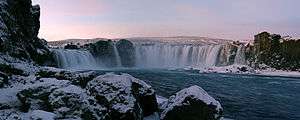Goðafoss
The Goðafoss (Icelandic: "waterfall of the gods" or "waterfall of the goði") is a waterfall in Iceland. It is located in the Bárðardalur district of Northeastern Region at the beginning of the Sprengisandur highland road. The water of the river Skjálfandafljót falls from a height of 12 meters over a width of 30 meters.[1] The river has its origin deep in the Icelandic highland and runs from the highland through the Bárðardalur valley, from Sprengisandur in the Highlands.
In the year 999 or 1000 the lawspeaker Þorgeir Ljósvetningagoði made Christianity the official religion of Iceland. According to a modern myth, it is said that upon returning from the Alþingi, Þorgeir threw his statues of the Norse gods into the waterfall.[2] The story of Þorgeir's role in the adoption of Christianity in Iceland is preserved in Ari Þorgilsson's Íslendingabók. "Íslendingabók", however, makes no mention of Þorgeir throwing his idols into Goðafoss. A window in Akureyrarkirkja, the Cathedral of Akureyri, illustrates this story.
MS Goðafoss, an Icelandic ship named after the waterfall, used to transport both freight and passengers. It was sunk by a German U-Boat in World War II, resulting in great loss of life.



See also
References
- ↑ Andrew Evans (2011). Iceland. Bradt Travel Guides. ISBN 184162361X, 9781841623610. Page 365.
- ↑ Svavar Sigmundsson. (2015, 29. júní). Er það rétt að Þorgeir Ljósvetningagoði hafi hent goðum í Goðafoss? Vísindavefurinn. Retrieved from http://visindavefur.is/svar.php?id=70316
| Wikimedia Commons has media related to Goðafoss. |
External links
- More information and photos about Goðafoss on Hit Iceland
- Edge of the Arctic- Places to See (English)
- Velkomin á Norðausturland: Áhugaverðir staðir (aka Edge of the Arctic- Places to See in Icelandic)
- World of Waterfalls: Goðafoss
- Panoramic virtual tour of Godafoss
Coordinates: 65°40′48″N 17°32′24″W / 65.68000°N 17.54000°W